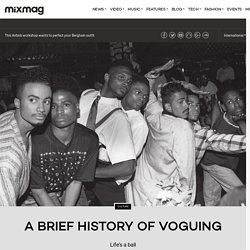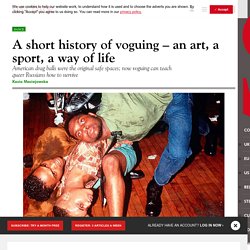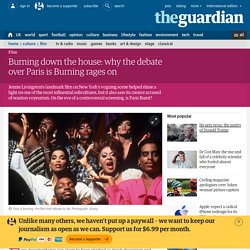

MikeQ Gives Us Some Ultimate Ballroom Bangers Ahead Of This Weekend's Sissy Ball. This Saturday 24 February Red Bull Music and Sydney Gay & Lesbian Mardi Gras are hosting one for the ages when the Sissy Ball takes over Redfern's Carriageworks for a night of disco-fuelled debauchery like no other.

Curated by interdisciplinary artist Bhenji Rha, Carriageworks will be transformed into a Vogue Dancefloor in the tradition of New York's underground ballroom scene, featuring New York judge Leiomy, MC Dashaun and performances from MikeQ, Electric Fields, Angel-Ho, Quay Dash and more. To mark the ocassion, New Jersey Native MikeQ has given us an exquisite list of all-time Ballroom classics, so slip on your dancing shoes and take a deep dive into some very special sounds. Gareth Pugh’s Judy Blame Ball: The Runway.
Strike a Pose, Forever: The Legacy of Vogue and its Re-contextualization in Contemporary Camp Performances. We don’t have to play victim anymore.

Our story has far surpassed Paris is Burning. We’re here and we’re here to stay. —Jamel Prodigy 1To be legendary, as stressed in Jennie Livingston’s esteemed documentary Paris Is Burning (1990), is recapitulative of the ballroom scene. Born to stand out, the ballroom subculture emerged as the paradigmatic anti-heteronormative indictment against ills and flaws sustained by the dominant American lifestyle. 2Taking the impact of Madonna’s song and video into account, vogue was cemented as a culturally iconic performance for future generations of the LGBT community to emulate. 3With regard to that, it is important to situate this movement within a postmodern economic and cultural context.
Vogue: A Seven-Part Guide to Ballroom Culture. In post-Internet society, things don't stay hidden for long.

But there is a subculture with more than three decades of relevance that has inspired its own documentary, been co-opted by Madonna, and yet, remarkably, remains largely misunderstood. "Walk down the street in Fort Lauderdale or South Beach, stop 20 gay men, and ask them about the icons in the ballroom scene," says Power Infiniti, mother of the House of Infiniti and ballroom culture veteran of more than 20 years. "Most of them wouldn't even know, never heard of 'em. It's such an underground world that not even most of our own community knows about it," he continues. "When you actually go to the balls, there's so much talent. See also: Catwalk Vogue Night: "A Place Where You Can Just Be You" Power Infiniti recently "adopted" Miami DJ Gooddroid into her "family," moved by the local's commitment to shedding light on vogue culture with the Catwalk at Grand Central's The Garret.
The History The Houses. A brief history of voguing - Culture. Director Jennie Livingstone found herself subject to similar criticism when her Paris Is Burning documentary was released the same year, with members of the ballroom community accusing her of exploiting them by reinforcing stereotypes by focusing on the tragic elements of the participants’ seemingly politically powerless lives, such as prostitution, AIDS and violence.

An encyclopaedic excursion through ballroom culture between 1986 and 1989, Paris Is Burning contrasted the flamboyance and liberation of the balls with the tragedy and troubles that the participants were experiencing. Though Livingston was criticised by some participants (a response to the film, How Do I Look? Was released in 2006, purporting to tell their ‘real’ story), it would have been impossible to create an honest depiction of the scene without including the hardship experienced by those that lived it.
A short history of voguing – an art, a sport, a way of life. It’s dance — but not as you know it.

A giddy mass of flying limbs, sashaying hips and pouty faces. Hands now stretched up high and fluttering as in flamenco, now on the ground buttressing cantilevered bodies and holding on to legs that seem to want to escape their owners. ‘I saw things I never saw before,’ David Byrne said after viewing a voguing battle in 1989. Don’t be fooled by the playfulness of the camp. Voguing is an art, a sport, a way of life — a combative display of agility that grew out of the American drag ball. The historian Tim Lawrence dates underground drag balls back to 1869, when Harlem’s Hamilton Lodge threw its first queer masquerade ball. To outfox the police, same-sex couples danced in drag. Burning down the house: why the debate over Paris is Burning rages on. The film alternates between colourful ballroom sequences – an acknowledged influence on current hit show RuPaul’s Drag Race – and candid interviews with key scene figures, who address an off-camera Livingston on complex subjects including class; race and racism; wealth; gender orientation; and beauty standards.

It’s also endlessly quotable, with characters dispensing terminology that’s since passed into popular parlance. Explaining the concept of ‘shade’, one of the film’s stars, Dorian Corey, purrs memorably: “I don’t have to tell you you’re ugly … I don’t have to tell you because you know you’re ugly.